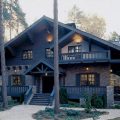Text: Valery Kitaev.
Plasma panel or video projector?
Your option is a video projector, if…
- You can allocate at least 40 sq. m. for a cinema hall.m: to watch movies comfortably, the distance between the viewer and the screen should be no less than three of its (the screen's) diagonals. Otherwise, the "cellular" nature of the image will be noticeable, and your eyes will quickly get tired.
- are you ready to completely darken (for example, withwith the help of blackout curtains) the room for the duration of the session. With significant external illumination (and even dim light from a sconce is considered as such), the "picture" on the screen loses contrast. If you have arranged a cinema in the living room, then for the duration of the session it will be completely removed from the "living space", which may cause discontent among household members who have other plans for the evening.
- there is free space in the house (from pictures, shelves, etc.)) plane for the screen. Don't expect to be able to project a movie on a regular white wall! You also need to find the right place for the projector. Even models equipped with the smartest geometric distortion correction systems should be placed strictly in the center of the screen. Ideally, they should be suspended from the ceiling.
Your option is plasma, if…
- the room allocated for the cinema hall does not reach 40 sq. m. Plasma is not so demanding on the room size. With a diagonal of 50 inches, a movie can be watched from a distance of 3-4 meters.
- You don't like pitch darkness.You can watch movies on a plasma panel even in daylight, and with a little dimming, the picture will acquire cinematic depth and contrast.
- You often watch TV programs.Plasma usually has built-in acoustics, which will perfectly cope with the "voice" of news or TV series. You do not want to turn on the surround sound system every time in order to watch the next episode of "Beautiful Nanny" or the program "Time"!
- you want to get a home theater"here and now", without remodeling the interior for it "from start to finish". By the way, it is not necessary to hang the plasma panel on the wall, all models are equipped with table stands.
 Home cinema hall
Home cinema hall


Architecture and Sound
The acoustics of a cinema hall largely depend on itsproportions. They should be as close as possible to the golden ratio formula: 1 (length) : 0.68 (width) : 0.32 (height). Do not try to set up a home theater in a room with ceilings lower than 2.2 m - low frequencies will never be harmonious here. The sound field in the room will be more uniform if the sound is reflected from the walls at an angle different from 90°. This can be achieved as follows:
- cover the opposite walls of the room with plasterboard so that they are at a slight angle (about 3 degrees) to each other;
- using the same plasterboard or furniture, create many protrusions and corners;
- install pilasters in the room; an acoustics specialist will help determine their optimal size.
Do not babble!
Do not place speakers close towall - this will lead to excessive low frequency boost (mumbling). Manufacturers recommend moving the speakers 1-1.5 meters away from the wall. Or at least 30-40 cm.


Soundproofing
Most often, cinemas are soundproofed withusing false walls made of plasterboard, installed at some distance from the real walls. The gap between them can be left hollow, but it is better to fill it with a fibrous sound absorber. The most effective option is multilayer panels in which "hard" (gypsum board, gypsum fiber) and "soft" (sound absorber) layers alternate. Their mechanism of action is simple: the sound is reflected from the "hard" layers and sinks into the "soft" ones. The panels are mounted to the wall through so-called vibration-isolating fastening units - this enhances their soundproofing ability.
Ambulance



Reliable rear
In five-channel surround sound systemsThe rear speakers are best placed on the side walls of the room, about half a meter above the head of a seated listener. In six-channel systems, an additional "center" rear speaker is placed behind the audience. But in seven-channel systems, everything is the other way around: the "main" speakers are installed at the back, and the additional ones are on the sides. Make sure that they are all at the same height.
Irresistible!
Surfaces (walls and furniture) located nearbyspeakers, should disperse the sound. Bookshelves and racks cope well with this task. But glass is the enemy of good acoustics, as it is a powerful sound reflector. Therefore, before the start of the session, be sure to curtain the windows - this will help improve the sound picture.












